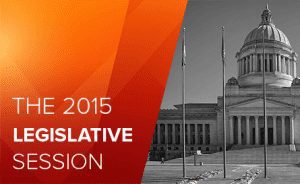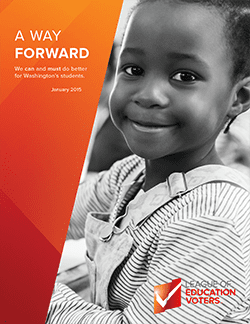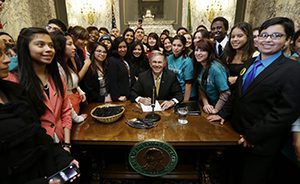League of Education Voters CEO Chris Korsmo sent the following letter to all Washington state legislators earlier today regarding the proposed rules for E2SSB 6552.
On behalf of the League of Education Voters, I applaud the Legislature for the passage of E2SSB 6552 and for the explicit recognition that “preparing students to be successful… requires increased rigor and achievement, including attaining a meaningful high school diploma with the opportunity to earn twenty-four credits.” I strongly agree and thank you for your leadership.
With the passage of 6552, we have a law that can increase rigor, empower local control and ensure consistency at the state level for high school graduation requirements.
At the League of Education Voters, we believe that every student in Washington state should have access to an excellent public education that provides the opportunity for success. E2SSB 6552 is a step in that direction. But only if implemented well.
Next week, the State Board of Education will vote on proposed rules guiding the implementation of this new law.
We have a number of concerns related to the implementation of the law and the proposed rules that are addressed in detail in the attached document.
Of particular concern to the League of Education Voters is the provision allowing students to waive credits. We have an economic imperative as a state to ensure that students are ready for the next step after high school, whether that is a career or post-secondary education. However, allowing any of the 24 credits to be waived results in less rigor, not more. In addition, high school graduation requirements should be consistent across the state. The proposed rules include significant flexibility for both school districts and for students, which incorporates the extensive discussions leading up to the passage of 6552. The State Board of Education has done exactly what the Legislature authorized them to do and any further changes to E2SSB 6552 should be made through additional legislation.
Thank you again for your work to ensure that each Washington student graduates from high school with a college and career ready diploma and the opportunity for success. Please review the attached addendum for more information about our specific concerns on the updated high school diploma. I welcome hearing from you on this important issue and working together during the 2015 legislative session.
Sincerely,
Chris Korsmo
CEO
Att: On the proposed rules for E2SSB 6552
 The League of Education Voters has long argued that a child’s education should be a continuum with seamless transitions from early learning through higher education. We have worked with partners around the state in pursuit of that vision, including with the Cradle through College Coalition. It is gratifying to see the Legislature following through with strategies and investments that support students at all ages. Read More
The League of Education Voters has long argued that a child’s education should be a continuum with seamless transitions from early learning through higher education. We have worked with partners around the state in pursuit of that vision, including with the Cradle through College Coalition. It is gratifying to see the Legislature following through with strategies and investments that support students at all ages. Read More 
 Chris Korsmo, CEO of the League of Education Voters, submitted an op-ed to The Seattle Times‘ Education Lab yesterday. It was published in The Seattle Times print edition on June 20.
Chris Korsmo, CEO of the League of Education Voters, submitted an op-ed to The Seattle Times‘ Education Lab yesterday. It was published in The Seattle Times print edition on June 20.